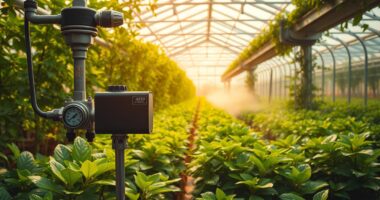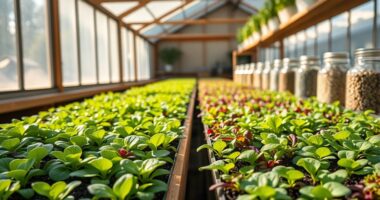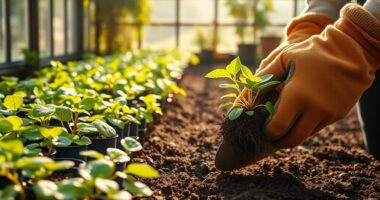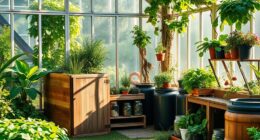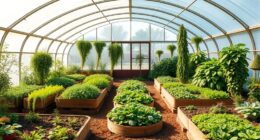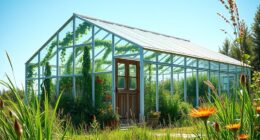Understanding light requirements for greenhouse plants is vital for their growth. You need to take into account both natural sunlight and supplemental lighting sources, especially during low-light periods. Each plant species has unique needs, so measuring light intensity and calculating Daily Light Integral (DLI) is essential. Factors like greenhouse materials and geographic location also affect light availability. To maximize light distribution and efficiency, there are several strategies you can implement for best plant health and yield. There's much more to explore on this topic.
Key Takeaways
- Different plant species have unique light requirements that vary by growth stage, influencing greenhouse planning and lighting needs.
- Measure light intensity using a quantum light meter to determine the Daily Light Integral (DLI) for optimal plant growth.
- Greenhouse materials can reduce light transmittance significantly, so select transparent materials like glass or polycarbonate for maximum light capture.
- Seasonal variations and geographic location affect natural sunlight availability, necessitating supplemental lighting during low-light periods.
- Implement shading systems and reflective surfaces to optimize light distribution while maintaining appropriate temperatures for plant health.
Understanding Light Types for Greenhouse Plants

When you're growing plants in a greenhouse, understanding the different types of light is vital for their success. Natural sunlight offers a full spectrum essential for photosynthesis, but its availability fluctuates with seasons and locations.
To guarantee your plants thrive, you might need supplemental lighting during low-light periods. The greenhouse structure also plays a role; certain materials can block 30-40% of incoming light, so choose wisely.
While excess sunlight can overheat your plants, requiring shading or ventilation, you'll need to balance light intensity to maintain peak temperatures.
Determining Light Intensity Requirements
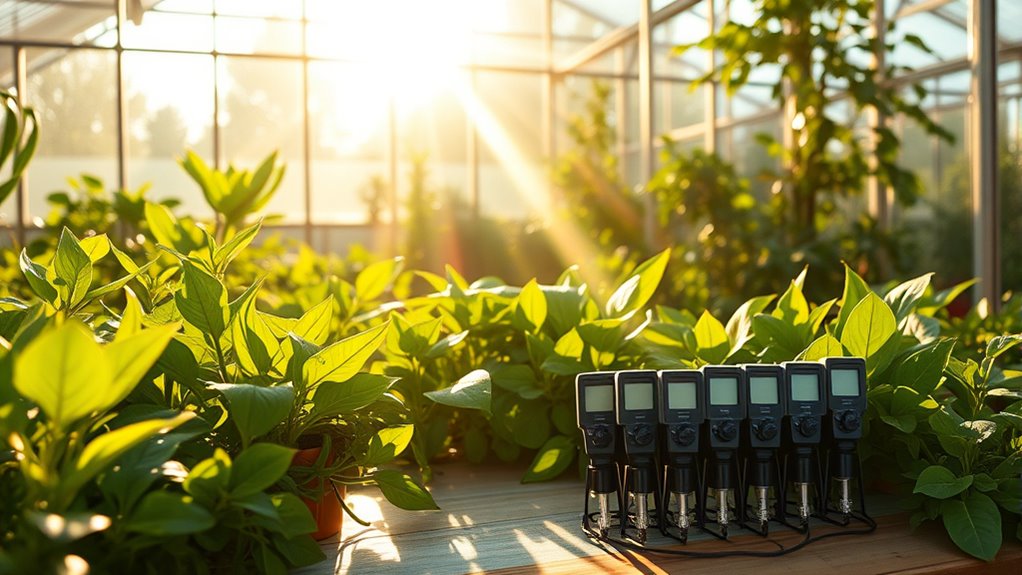
Understanding the types of light is just the beginning; now it's time to determine how much light your greenhouse plants need.
Start by measuring light intensity with a quantum light meter to assess the natural light available. Calculate the Daily Light Integral (DLI) in mol/m²/day to understand the total photosynthetic radiation your plants receive.
Remember, greenhouse materials can cut light transmittance by 10% to 50%, which affects your plants' light intake. Each crop has specific DLI requirements, so consider these when planning for supplemental lighting.
Seasonal variations also play a role, as winter months often require extra light due to decreased natural sunlight.
Factors Influencing Light Needs
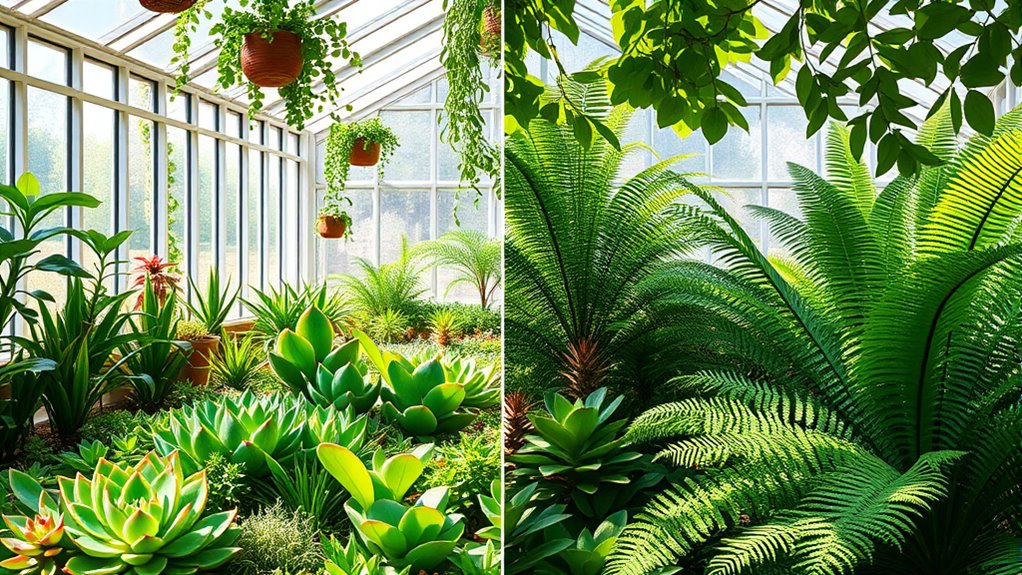
Various factors influence the light needs of greenhouse plants, and recognizing these can help you tailor your growing environment for ideal growth.
First, different plant species have unique light requirements, which change during their growth stages—like needing more blue light when vegetative and red light when flowering.
Different plants require varying light spectrums at different growth stages, needing more blue light during vegetative growth and red light for flowering.
The greenhouse structure also plays a role; its shape, orientation, and covering materials can affect light distribution.
Additionally, your geographic location impacts natural sunlight availability and seasonal changes, necessitating adjustments in lighting strategies.
Finally, consider lighting technology; modern LEDs offer customizable spectrums, while energy efficiency and heat management are essential for sustainability.
Strategies for Optimizing Light Distribution
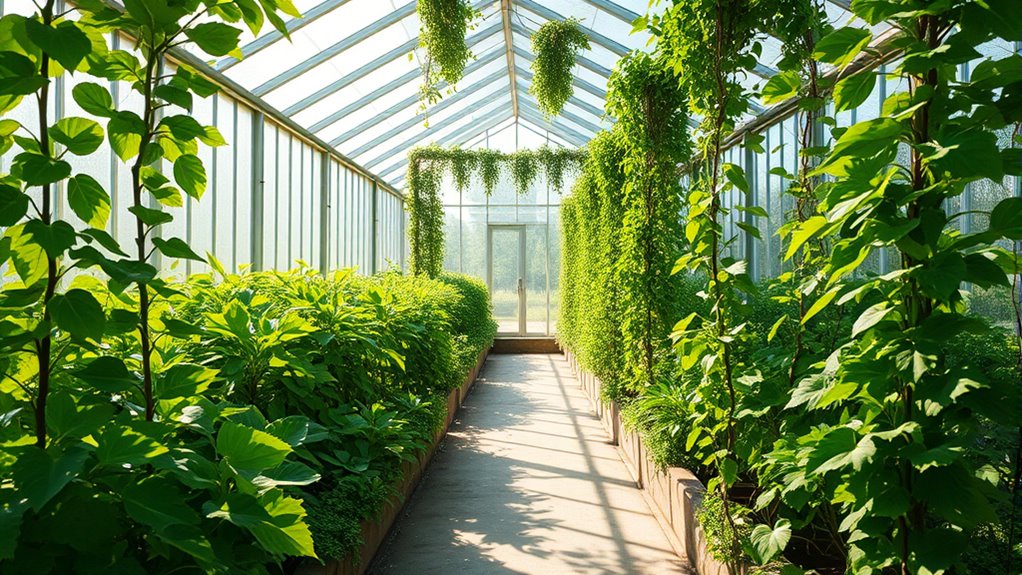
To maximize light distribution in your greenhouse, consider several effective strategies that cater to your plants' needs.
First, orient your greenhouse south or southwest to capture the most sunlight. Use materials like glass or transparent polycarbonate that allow high light transmission, and keep them clean to avoid dust buildup.
Implement shading systems to regulate heat while ensuring 70% to 80% light diffusion for uniform growth. You can also divide your space into zones tailored to specific crops, adjusting lighting for each microclimate.
Reflective surfaces like Mylar can enhance light distribution, and proper plant spacing is essential for maximizing light exposure.
Finally, consider automated lighting control systems to efficiently manage light cycles and intensity.
Supplemental Lighting Options
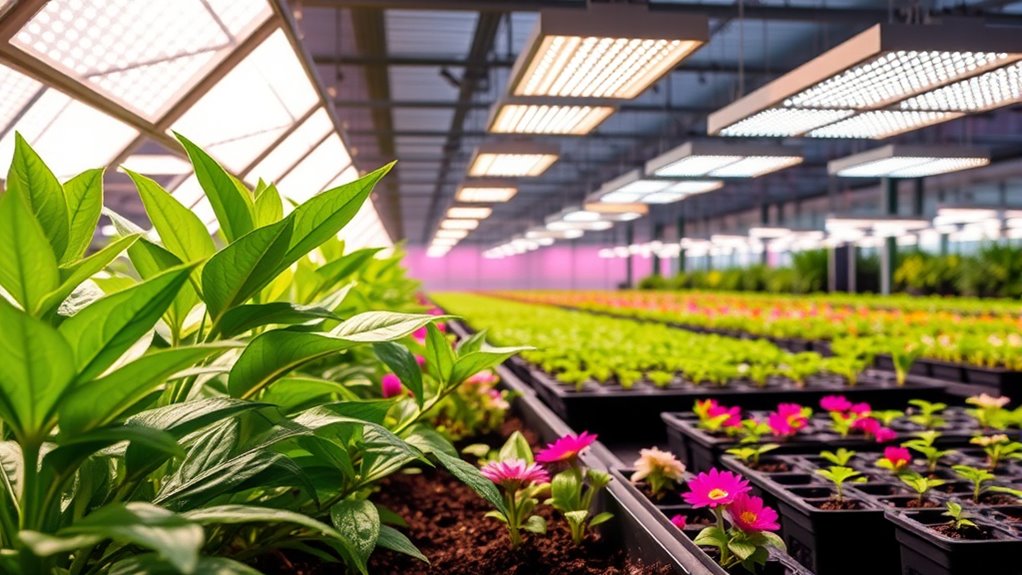
When natural light falls short, supplemental lighting options become essential for maintaining healthy plant growth in your greenhouse. High Intensity Discharge (HID) lighting, including metal halide and high-pressure sodium lamps, is a common choice.
Fluorescent lights provide uniform light distribution, while energy-efficient LED lighting allows for adjustable spectrum, though it has a higher upfront cost. You might also consider incandescent lighting, but it's less efficient.
Photoperiod lighting helps control flowering cycles. Supplemental lighting boosts crop production, improves quality, and shortens growth cycles, ensuring year-round consistency.
It's especially beneficial for high-value crops during winter months or cloudy days. Choose the right option based on your crop requirements and space availability to maximize your greenhouse's potential.
Best Practices for Greenhouse Lighting

While utilizing natural sunlight is crucial for plant growth, implementing best practices for greenhouse lighting guarantees your plants thrive year-round.
Start by managing light intensity; aim for 10,000 to 20,000 lux for ideal growth. Incorporate reflective surfaces like Mylar or white paint to distribute light evenly.
Don't forget temperature control; excessive sunlight can cause overheating, so make sure proper ventilation and shading.
Choose the right light spectrum, especially red for fruiting plants, to meet specific needs.
Design your greenhouse to minimize shadows and maximize light entry.
Regular maintenance, including cleaning surfaces, is essential to maintain ideal light transmission.
The Role of Light Duration in Plant Growth
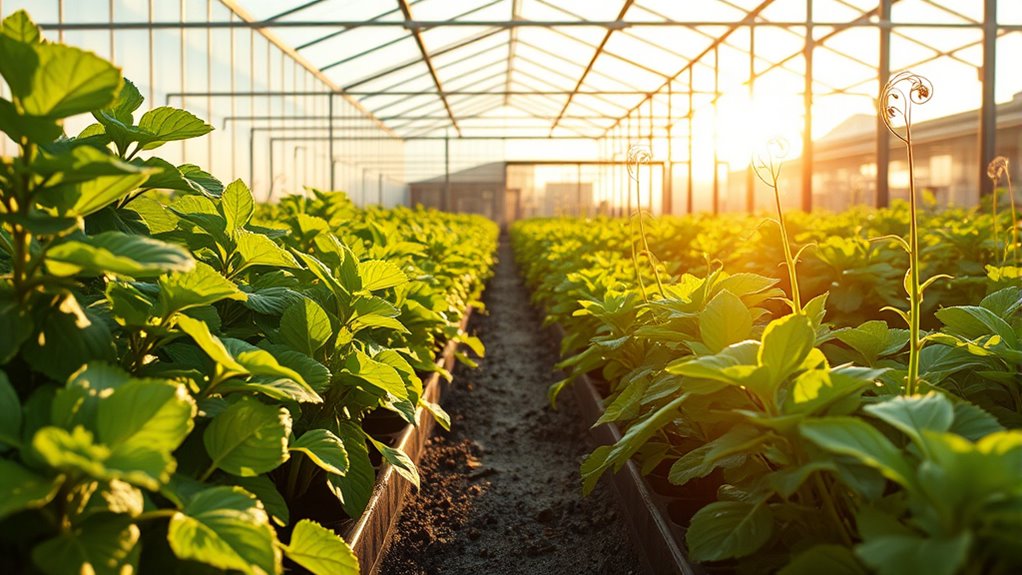
Light duration plays an essential role in plant growth, as it directly influences photosynthesis and overall development. When you extend light periods, your plants can enhance photosynthetic activity, leading to increased food production and growth.
In controlled environments, continuous light can offer ideal photosynthetic photon flux density (PPFD), improving energy efficiency while reducing peak power needs. While some species thrive under longer photoperiods, accumulating more dry matter, others might experience stunted growth.
You'll also notice that plants may change in leaf anatomy and nutrient content due to continuous light. Understanding these variations helps you tailor light duration to your specific plants, maximizing their growth patterns and ensuring they receive the right amount of light for healthy development.
Seasonal Considerations for Greenhouse Lighting

As seasons change, the light available for greenhouse plants fluctuates considerably, impacting their growth and development.
In winter, minimal sunlight often requires you to use supplemental lighting to keep plants thriving. Conversely, summer brings high natural light, which might necessitate shading to prevent overheating and excessive exposure.
Cloud cover can also increase your need for extra lighting. Different geographical locations will further affect the length of daylight, so consider your specific area when planning.
Remember, daily light integral (DLI) varies seasonally, influencing your lighting strategy.
Plants respond to these seasonal changes, affecting flowering and growth patterns, so adjust your lighting setup to meet their needs and avoid stress caused by inadequate or excessive light.
Energy Efficiency in Greenhouse Lighting Solutions
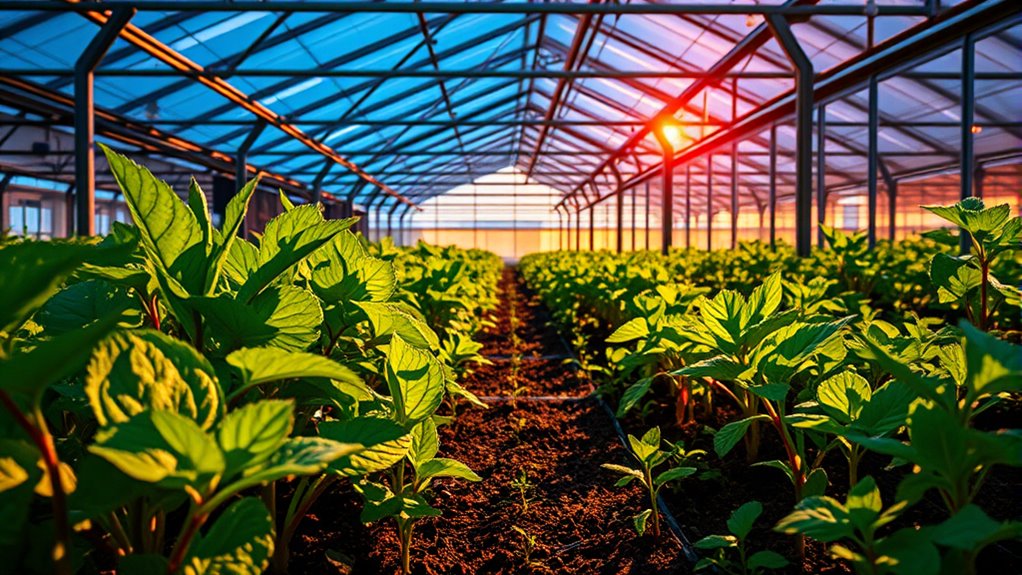
To maximize energy efficiency in greenhouse lighting, growers should consider the advantages of modern LED technology over traditional systems.
LED grow lights use up to 20% less energy than HPS systems while providing comparable or superior light quality. With the ability to save up to 80% on energy costs, investing in high-efficiency LED fixtures makes financial sense. These lights offer directional lighting, minimizing waste, and feature adjustable spectra for tailored growth conditions. Additionally, they can significantly enhance overall well-being through improved air quality in greenhouse environments. Plus, their long lifespan reduces replacement costs.
Integrating smart controllers allows for automated light cycles, enhancing efficiency further. Additionally, like modern heat pumps, LED lighting systems can incorporate advanced filtration systems to improve indoor air quality in greenhouse environments.
By choosing LEDs, you not only cut costs but also lower your carbon footprint, promoting a more sustainable growing environment.
Embrace LEDs for a greener, more profitable greenhouse.
Frequently Asked Questions
How Does Light Color Affect Plant Growth in Greenhouses?
Light color greatly affects your plants' growth in greenhouses.
Red light boosts photosynthesis, encouraging flowering and fruiting, while blue light supports healthy vegetative growth and chlorophyll production.
If you use full-spectrum lighting, you can mimic natural sunlight, providing balanced conditions for your plants.
Remember to take into account the specific light needs of different crops, as each has unique requirements that can influence their growth stages and overall health.
Can Too Much Light Harm Greenhouse Plants?
Did you know that excessive light can burn up to 50% of a plant's leaves if not managed correctly?
Yes, too much light can harm your greenhouse plants. It can lead to leaf burn and stress, disrupting essential processes like photosynthesis.
If you notice signs of overheating or discoloration, it's vital to adjust your lighting setup.
Implementing shading or ventilation can help prevent damage and keep your plants thriving.
What Are the Signs of Light Stress in Plants?
When you notice signs of light stress in your plants, look for a few key symptoms.
If leaves are bleaching or turning pale yellow, excessive light might be the culprit. You might also see crispy, scorched leaves resembling sunburn.
On the other hand, stunted growth and leggy, elongated stems can indicate insufficient light.
Keep an eye out for these signs to guarantee your plants stay healthy and thriving.
How Do Different Plant Species' Light Needs Vary?
Imagine each plant as a unique musician, playing its own tune when it comes to light needs.
Some, like cacti, crave bright, unfiltered sunshine, while others, such as ferns, prefer a softer, shaded melody.
Tropical plants, like orchids, need a spotlight to flourish, whereas many vegetables find harmony in moderate light.
As you care for them, remember their distinct preferences shape their growth, just like different instruments create varied symphonies.
Are There Specific Light Requirements for Flowering Plants?
Yes, flowering plants have specific light requirements.
You'll typically need a minimum of 10,000 to 20,000 lux for healthy growth. Some varieties, like orchids, might demand even more.
It's also crucial to provide a balanced light spectrum, combining blue and red light to support photosynthesis and flowering.
During winter or cloudy days, consider using supplemental lighting to maintain ideal conditions and guarantee your plants thrive throughout their blooming period.
Conclusion
In the world of greenhouse gardening, light isn't just important; it's the lifeblood of your plants! Without the right light, your precious greens can wither away faster than you can say "photosynthesis." By mastering light types, intensity, and duration, you'll release a botanical revolution that'll make your plants thrive like never before! So, grab those grow lights and watch your greenhouse transform into a lush paradise, bursting with life and color. Your plants are counting on you!


